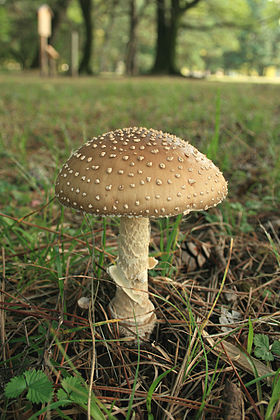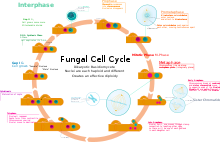Dikarya
| Dikarya | |
|---|---|
 Loài nấm Amanita pantherina thuộc chi Amanita giới Basidiomycota | |
| Phân loại khoa học | |
| Liên vực (superdomain) | Neomura |
| Liên giới (superregnum) | Eukaryota |
| Nhánh | Unikonta |
| Nhánh | Opisthokonta |
| Giới (regnum) | Fungi |
| Phân giới (subregnum) | Dikarya |
| Divisions | |
Entorrhizomycota | |
| Danh pháp đồng nghĩa[1] | |
Carpomycetaceae Bessey (1907) | |
Dikarya là một phân giới của giới Nấm, bao gồm ba ngành nấm Ascomycota, Basidiomycota và Entorrhizomycota. Về mặt phát sinh chủng loại học, hai ngành này thường được xếp vào cùng với nhau.[2][3]
Phát sinh loài
[sửa | sửa mã nguồn]
| |||||||||||||||||||||||||||||||||||||||||||||||||||||||||||||||||||||
| Cây phát sinh loài của ngành Dikarya[1] |
Phân loại giới nấm năm 2007 là kết quả của một nỗ lực hợp tác nghiên cứu trên quy mô lớn với sự tham gia của hàng chục nhà nấm học và các nhà khoa học khác nghiên cứu về phân loại nấm.[1]
Sinh sản hữu tính
[sửa | sửa mã nguồn]

Ngành Ascomycota được đặc trưng bởi bào tử giảm phân gọi là ascospore (bảo tử chứa nang) kèm theo một túi đặc biệt là nang.[4]
Xem thêm
[sửa | sửa mã nguồn]- Giới Nấm
Chú thích
[sửa | sửa mã nguồn]- ^ a b c Hibbett, D.S.; và đồng nghiệp (tháng 3 năm 2007). “A higher level phylogenetic classification of the Fungi”. Mycological Research. 111 (5). tr. 509–47. doi:10.1016/j.mycres.2007.03.004. PMID 17572334.
- ^ Lutzoni, F.; và đồng nghiệp (2004). “Assembling the fungal tree of life: progress, classification, and evolution of subcellular traits”. American Journal of Botany. 91 (10). tr. 1446–80. doi:10.3732/ajb.91.10.1446. PMID 21652303.
- ^ James, T.Y.; và đồng nghiệp (2006). “Reconstructing the early evolution of Fungi using a six-gene phylogeny” (PDF). Nature. 443 (7113). tr. 818–22. doi:10.1038/nature05110. PMID 17051209. Bản gốc (PDF) lưu trữ ngày 11 tháng 6 năm 2007. Truy cập ngày 23 tháng 9 năm 2017. Đã định rõ hơn một tham số trong
|archiveurl=và|archive-url=(trợ giúp) - ^ Wallen RM, Perlin MH (2018). “An Overview of the Function and Maintenance of Sexual Reproduction in Dikaryotic Fungi”. Front Microbiol. 9: 503. doi:10.3389/fmicb.2018.00503. PMC 5871698. PMID 29619017.
Liên kết ngoài
[sửa | sửa mã nguồn]- AFTOL classification at Dave Hibbett's site Lưu trữ 2021-04-23 tại Wayback Machine
Phân loại nấm, Danh sách họ nấm | |||||||||||||||||
|---|---|---|---|---|---|---|---|---|---|---|---|---|---|---|---|---|---|
| Dikarya |
| ||||||||||||||||
| Glomeromycota |
| ||||||||||||||||
| Zygomycota |
| ||||||||||||||||
| Khác | |||||||||||||||||
Text is available under the CC BY-SA 4.0 license; additional terms may apply.
Images, videos and audio are available under their respective licenses.
